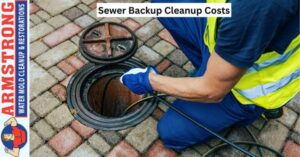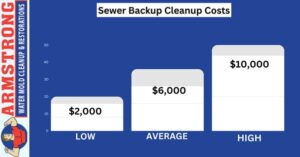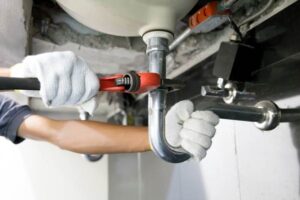
Flooded basement or a sewage nightmare? Find out how much sewer backup cleanup can cost!
When disaster strikes, the last thing you want to worry about is the cost of cleanup. Understanding the sewer backup cleanup cost can help you make informed decisions. Let’s break down what you can expect to pay for sewer backup services and what’s included in the price, so you’re not left in the dark during an emergency.
Breakdown the cost of Sewer Backup Cleanup
| Service Type | Low Cost | High Cost | Average Cost | |||
| Sewer Backup Cleanup cost |
|
|
|

When the Sewers Strike Back: Your Guide to Cleanup Costs and Solutions!
| Service Type | Average Cost | What’s Included |
| Basic Sewer Backup Cleanup | $1,000 – $3,000 | This includes the removal of sewage, water extraction, and sanitization of affected areas. Necessary repairs may cost extra, depending on the extent of the damage. |
| Full Cleanup & Restoration | $2,500 – $7,000 | Complete cleanup, mold remediation, water damage repair, and structural restoration. Includes all aspects of cleanup and restoration of the affected area. |
| Inspection & Evaluation | $150 – $500 | A professional inspection of your property to assess the damage, locate blockages, and determine the extent of sewer backup. |
| Emergency Response Service | $500 – $1,500 | Available 24/7, this service includes immediate response, water extraction, and temporary fixes to prevent further damage before a full cleanup. |
| Insurance Adjuster Assistance | $100 – $300 per hour | Costs associated with having an insurance adjuster review the damage and assist with filing a claim for sewer backup cleanup costs. |
Introduction
Dealing with a sewer backup is stressful, but understanding the sewer backup cleanup cost can help you plan for this unfortunate event. Knowing the sewer backup cleanup price is crucial for your budgeting, whether you need professional assistance for cleanup, repairs, or inspection. This guide will cover the average sewer backup cleanup charges, including what is typically included in the cost of sewer backup cleanup services.
Types of Sewer Backup
Stormwater Sewer Backup
Stormwater sewer backups occur when heavy rainfall overwhelms the drainage system, causing water to back up into homes. This often happens in urban areas with inadequate stormwater infrastructure. Furthermore, blocked or damaged storm drains can worsen the problem, leaving homeowners with flooding and potential water damage to address quickly.
Sanitary Sewer Backup
Sanitary sewer backups are caused by blockages or damage within the sewer line that handles household wastewater. When grease, debris, or other materials clog the system, wastewater can flow back into your home. Moreover, these backups pose serious health risks due to contamination, making professional cleanup essential to prevent illness and further damage.
Combined Sewer Backup
Combined sewer backups result from systems that handle both stormwater and wastewater in a single pipeline. During heavy rains, these systems can exceed their capacity, leading to a mix of stormwater and sewage entering homes. Not only does this type of backup cause significant property damage, but it also creates a hazardous environment due to raw sewage exposure.
Tree Root Intrusion Backup
Tree root intrusion backups occur when roots grow into sewer lines in search of water, creating blockages or even breaking pipes. Over time, as roots expand, they can completely obstruct the flow of wastewater, causing backups. Additionally, this type of backup can be particularly challenging to fix, often requiring specialized equipment to remove the roots and repair the damage.
Clogged Drain Line Backup
Clogged drain line backups are among the most common issues, often resulting from grease, food waste, hair, or other debris accumulating in pipes. As these materials build up, they restrict water flow, eventually causing backups. Fortunately, this type of backup is usually preventable with regular maintenance and proper waste disposal practices.
Collapsed Sewer Line Backup
Collapsed sewer line backups occur when aging or damaged pipes collapse, blocking the flow of wastewater entirely. This can happen due to soil movement, corrosion, or external pressure on the pipes. As a result, backups become unavoidable until the damaged section is repaired or replaced. Consequently, addressing a collapsed sewer line promptly is critical to restoring proper function and preventing extensive property damage.
| Type of Sewer Backup | Estimated Cost Range |
| Stormwater Sewer Backup | $1,500 – $7,500 |
| Sanitary Sewer Backup | $2,000 – $10,000 |
| Combined Sewer Backup | $3,000 – $15,000+ |
| Tree Root Intrusion Backup | $1,000 – $8,000 |
| Clogged Drain Line Backup | $300 – $1,500 |
| Collapsed Sewer Line Backup | $4,000 – $20,000+ |
Causes and Effects of Sewer Backups
Stormwater Sewer Backup
Cause: Heavy rainfall overwhelms the drainage system, often in urban areas with insufficient stormwater infrastructure.
Effect: Flooding in homes, water damage, and potential mold growth that requires immediate attention.
Sanitary Sewer Backup
Cause: Blockages or damage in household sewer lines due to grease, debris, or foreign objects.
Effect: Contamination from wastewater, posing health risks and causing damage to property.
Combined Sewer Backup
Cause: Combined systems for stormwater and wastewater exceed capacity during heavy rains.
Effect: Mixed stormwater and sewage backflow, leading to severe property damage and hazardous contamination.
Tree Root Intrusion Backup
Cause: Tree roots grow into sewer pipes, causing blockages or breaking the pipes.
Effect: Obstructed wastewater flow, requiring costly repairs and potential excavation.
Clogged Drain Line Backup
Cause: Grease, hair, food waste, or debris accumulate in pipes, blocking water flow.
Effect: Minor backups that can escalate into more significant plumbing issues if not addressed promptly.
Collapsed Sewer Line Backup
Cause: Aging or damaged pipes collapse due to soil movement, corrosion, or external pressure.
Effect: Total blockage of wastewater flow, causing extensive property damage and requiring major repairs.
Factors that impact on Sewer Backup Cleanup Costs
| Factor | Impact on Cost |
| Severity of Damage | More extensive damage requires higher cleanup and repair costs. |
| Type of Backup | Combined sewer backups and raw sewage contamination are costlier to address. |
| Location of Issue | Hard-to-reach or underground pipe damage increases costs. |
| Extent of Contamination | High contamination levels demand thorough cleaning and sanitization. |
| Repair or Replacement Needs | Pipe replacement or excavation significantly raises costs. |
| Professional Services Used | Specialized equipment or services add to the overall expense. |
Is your home at risk? Discover how sewer backup cleanup costs could impact your budget!
Sewer Backup Cleanup Costs vs other types of water damage clean up services cost
| Service Type | Low Cost | High Cost | Average Cost | |||
| Flood Damage Cleanup cost | $1,000 | $6,000 | $3,500 | |||
| Storm Damage Cleanup cost |
|
|
| |||
| Sewer Backup Cleanup cost |
|
|
| |||
| Plumbing Leak Cleanup cost |
|
|
| |||
| Roof Leak Cleanup cost |
|
|
| |||
| Appliance Malfunction Cleanup cost | $100 | $200 | $400 | |||
| Ice Dam Water Damage Cleanup cost | $1,500 | $3,000 | $5,000 | |||
| Hot Water Heater Leak Cleanup cost | $150 | $3,60 | $6,50 | |||
| HVAC System Leak Cleanup cost | $300 | $7,500 | $3,900 |
Summary

Sewer backup cleanup costs in 2025 can vary significantly based on the type, severity, and required repairs. Whether it’s a stormwater backup, a collapsed sewer line, or tree root intrusion, these incidents can lead to significant property damage, health risks, and financial burdens. Understanding the factors influencing these costs ensures homeowners are better prepared to address emergencies effectively.
Don’t leave your home and health at risk—consult with an expert to assess your sewer backup situation and get a tailored solution for your needs. Professional assistance not only ensures a thorough cleanup but also helps prevent future issues.
Click here to schedule a consultation with sewer backup experts today!
FAQs
Factors include the type of backup, extent of damage, and required repairs.
Only if you have additional sewer backup coverage.
Basic cleanup: 1–2 days; extensive repairs: up to a week.
It’s unsafe due to contaminants—professional cleanup is recommended.
Regular maintenance, proper waste disposal, and backwater valve installation.
